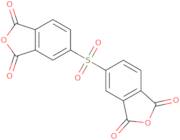3,3',4,4'-Diphenylsulfonetetracarboxylic Dianhydride
CAS: 2540-99-0
Ref. 3D-FD62693
| 1g | Descatalogado | ||
| 2g | Descatalogado | ||
| 5g | Descatalogado | ||
| 10g | Descatalogado | ||
| 500mg | Descatalogado |
Información del producto
- 4,4'-Sulfonyldiphthalic Anhydride
- 1,3-Isobenzofurandione, 5,5′-sulfonylbis-
- 3,3'-4,4'-Tetra Carboxylic acid and Anhydride Diphenyl Sulfone
- 3,3,4,4-Diphenylsulfonetetracarboxylic dianhydride
- 3,3′,4,4′-Biphenylsulfone tetracarboxylic dianhydride
- 3,3′,4,4′-Diphenyl sulfone tetracarboxylic acid dianhydride
- 3,3′,4,4′-Diphenyl sulfone tetracarboxylic anhydride
- 3,3′,4,4′-Diphenyl sulfone tetracarboxylic dianhydride
- 3,3′,4,4′-Tetracarboxydiphenyl sulfone dianhydride
- 4,4′-Diphthalic anhydride sulfone
- Ver más sinónimos
- 4,4′-Sulfonylbis(phthalic anhydride)
- 4,4′-Sulfonyldiphthalic acid dianhydride
- 4,4′-Sulfonyldiphthalic anhydride
- 5,5'-Sulfonylbis(2-Benzofuran-1,3-Dione)
- 5,5′-Sulfonylbis[1,3-isobenzofurandione]
- Bis(3,4-dicarboxyphenyl) sulfone dianhydride
- Diphenyl sulfone-3,4,3′,4′-tetracarboxylic dianhydride
- NSC 689416
- Phthalic anhydride, 4,4′-sulfonyldi-
- Rikacid DSDA
3,3',4,4'-Diphenylsulfonetetracarboxylic dianhydride (DPSD) can be used as a cell-growth regulator. It has been shown to up-regulate the expression of genes in human tissue culture cells and yeast cells, including carbon source uptake, intracellular levels of 3-hydroxypropionic acid, and synthase gene expression. DPSD has also been shown to inhibit the growth of Pseudomonas aeruginosa and Mycobacterium tuberculosis. The molecular weight of DPSD is 872 Da and it is soluble in water. This compound is synthesized by the condensation reaction between tetracycline hydrochloride and 2,2'-dichlorodiphenylsulfone. The chemical structure of DPSD consists of amide bonds connecting aromatic rings with sulfonate groups. The nmr spectra for this compound





